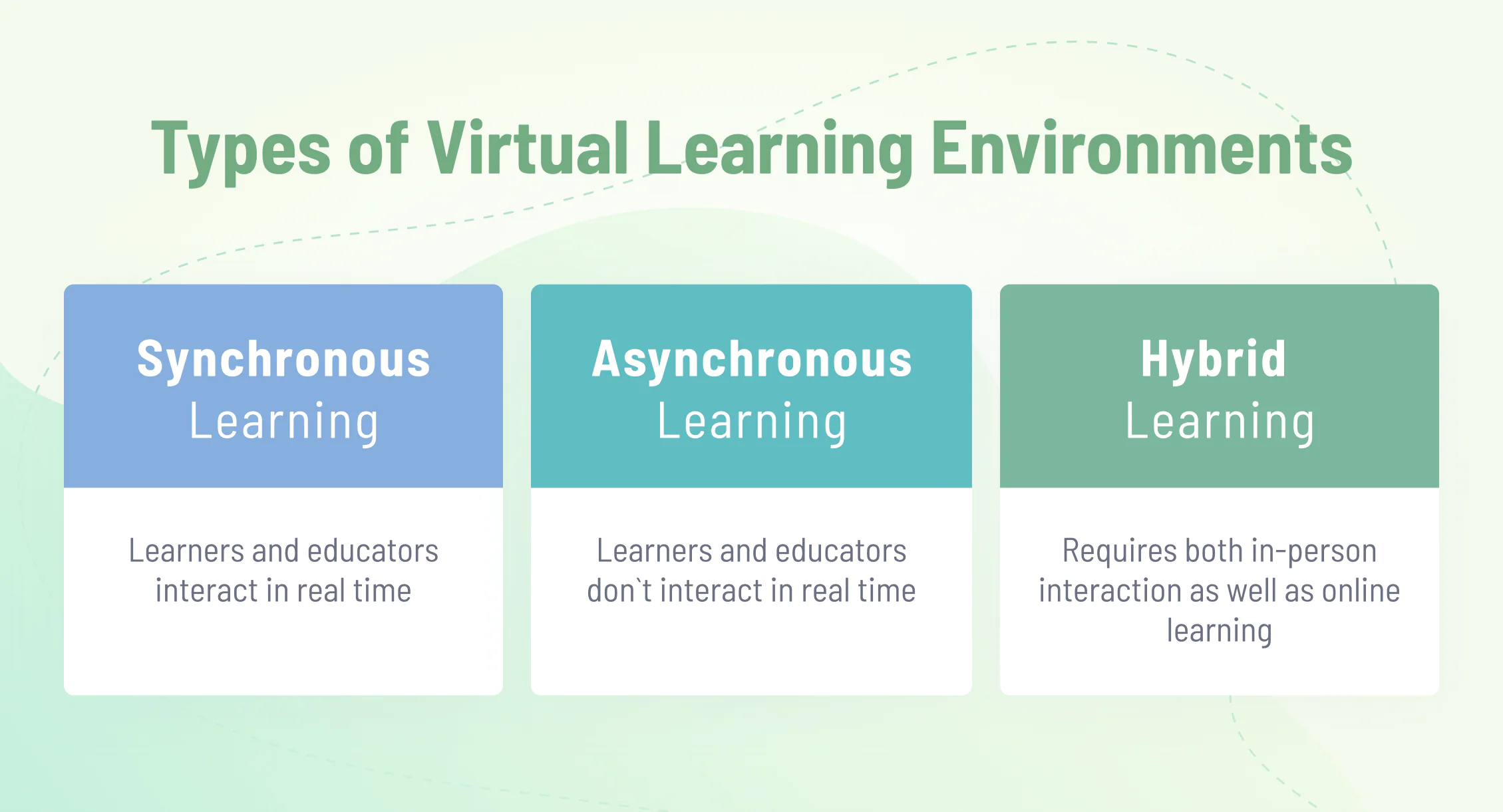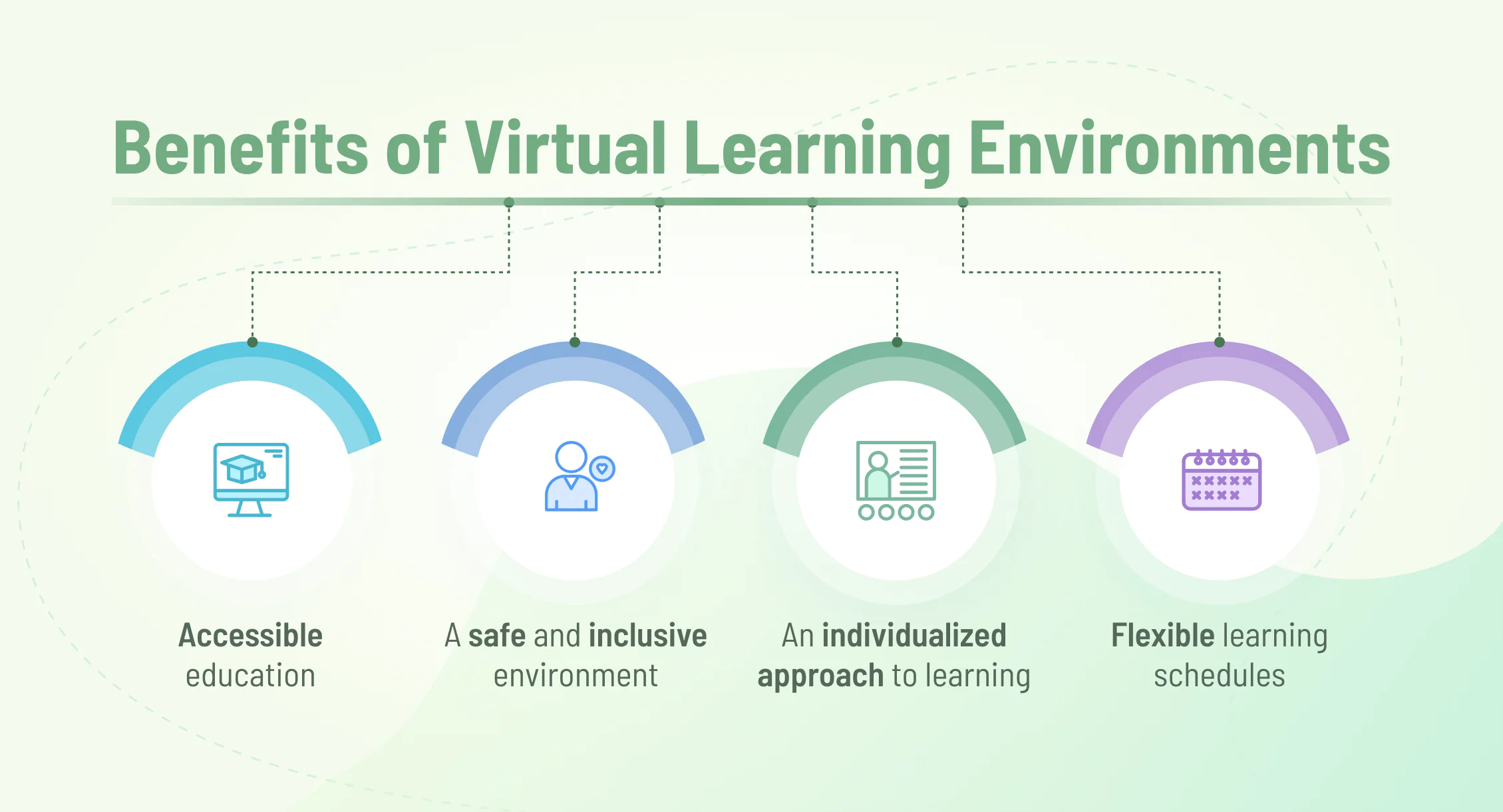Online training platforms grant access to classes and other helpful information online, no matter the distance. Such platforms usually improve the global teaching process. A virtual learning environment, or VLE, is an educational mechanism that improves teaching and learning methods by providing a broader scope of tools and advanced connectivity among students and teachers.
Key Characteristics of Virtual Learning Environment
A proper educational platform should contain aspects that affect the quality of the studying process, such as:
- An array of valuable tools. Educators can generate plans, while students can complete and submit given projects using various methods.
- A personalized experience. Content is handled based on personal progress during a course. This helps to keep learners interested in their studies.
- Personal progress tracker. Every student can monitor their grades and take steps if their performance falls.
- Offline learning. If a student can’t connect to an online course due to a bad connection, they can still get the recorded lesson and learn the material in electronic form.
- Notifications. Teachers are notified of students’ success, deadlines, and schedules. This allows them to draw the attention of confused students as needed.
- Learning materials. This allows platform users to stay organized and well-informed by providing an accessible area for all educational materials.
- Reporting and analytics. Personalized reports, feedback, and visual dashboards that display learned data help educators determine where students struggle.
- Assessment tools. Teachers can assess how students respond to their learned materials, which helps them enhance course content and provide personal comments and recommendations.
- Flexible scheduling. Educators can construct several types of assessments and let students decide on their schedule.
- Integration with other systems. Thanks to their interconnections, such systems provide improved management of learning consequences. Educators, in particular, will find it simpler to evaluate students’ performance when combined with valuable data insights from other platforms.
Types of VLEs: Synchronous, Asynchronous, Hybrid
Not all virtual learning platforms work the same way. There are three distinct types of virtual learning environments.
Synchronous
Teachers broadcast their lectures, with users participating in real-time by camera, microphone, or live chat, providing a more interactive learning environment.
Asynchronous
Pre-recorded lectures are available for students to watch whenever they choose. The teacher will publish a video or audio recording, as well as lecture notes. Often, there is an exam on the subject to ensure that students follow lectures and stay on track with the class schedule.
Hybrid
This approach combines both methods mentioned above. Consider enrolling in a hybrid course if you want the flexibility to study when it is most convenient for you while receiving organized sessions and communication with a teacher.
How Does a Virtual Learning Environment Work?
This virtual class enables educational processes based on novel dynamics, such as distant classes and on-demand material consumption.
Course management
Instructors can design, plan, and manage course content, assignments, and evaluations using platforms like Moodle or Blackboard. Students can access a gateway for course materials and timetables, making it easier to manage personal progress.
Content delivery
VLEs provide information via multimedia, lectures, and interactive resources. Learning tools and platforms can adapt information delivery, addressing individual student requirements and increasing participation.
Communication and Collaboration
VLEs encourage contact through discussion boards, live chat, and other integrated messaging services. Collaboration is fostered through group projects and virtual classrooms, allowing real-time connection and peer participation. This encourages a dynamic environment outside of regular classrooms.
Benefits of Virtual Learning Environments
Online studying allows students to access courses from anywhere, making studying extremely convenient, even long-distance.
Accessible education
With VLEs eliminating geographical restrictions, learners can get an education anywhere in the world. Users will have access to high-quality learning materials, encouraging inclusion and democratizing the teaching process.
A safe and inclusive environment
VLEs provide a secure environment for learners while encouraging inclusion by supporting a variety of demands. Students feel encouraged to express themselves, which promotes a more tolerant and inclusive learning atmosphere.
An individualized approach to learning
VLEs provide individualized learning by tailoring material and speed to specific student requirements. Adaptive technology and analytics help educators discover strengths and shortcomings, allowing them to adjust their approach and improve overall learning results.
Flexible learning schedules
VLEs provide more flexibility by letting students learn at their own pace and according to their schedules. This flexibility is beneficial for those who work or have children. This makes education accessible and adaptive to a variety of lifestyles.
Disadvantages of Virtual Learning Environments
Technology provides many benefits, such as learning from home, but can also cause several educational issues.
Limited social interaction
VLEs lack the face-to-face contact required for social growth. Reduced personal connections can influence collaboration skills and the social components of the school, thus impairing the overall learning experience.
Technical difficulties
Reliance on technology raises the possibility of technical issues such as network problems, software errors, or device malfunctions. These issues can disrupt the class flow, frustrating both instructors and students.
Potential distractions in the virtual learning environment
Virtual learning can expose students to various distractions (home activities or social media). Maintaining attention becomes difficult, potentially compromising the quality of the final learning results.
Value of Virtual Learning Environments for the Educational Process
VLEs are a crucial component of the educational process, especially as individuals become increasingly immersed in the digital world. Virtual environments must include virtual classrooms, support resources, supplementary materials, contact channels, and pages for students to submit exercises and take examinations.
Democratization of education
By breaking down traditional approaches, VLE platforms provide access to education regardless of geographic location, socioeconomic background, or physical restrictions. This promotes diversity and empowers those who may have previously faced barriers to formal education, resulting in a more equal and knowledge-driven society.
Personalized learning
Moreover, the platform facilitates individual and group performance evaluations and provides complete data on class progress.
A personalized approach is a major benefit of virtual studying. Students can work at their own speed, reinforcing learning in areas of difficulty and rushing through known material. This personalized approach guarantees each student receives tailored help, resulting in a more successful experience.
Creating an inclusive online learning environment
VLEs help create a friendly, inclusive environment by removing conventional obstacles. Students with physical limitations have easier access to information, while features like closed captioning improve accessibility for students with hearing difficulties. Overall, the inclusive character of virtual learning guarantees education is available to a wide range of people, encouraging diversity and equitable opportunity for all students.
Best Practices in Creating Virtual Learning Environments
The following suggestions provide educators with practical approaches to creating an engaging and dynamic virtual learning experience through strong community, collaboration, and instructional learning methodologies. While these principles also apply to in-person learning, they are especially crucial when engaging students in online learning environments.
Interactive and engaging content
Create a VL environment, including dynamic and interesting material. Include interactive features like films, quizzes, and role-play simulations to increase student engagement. Interactive conversations, group tasks, and real-world applications keep students engaged, creating dynamic and exciting conditions for compelling online study.
Adaptive learning
Implement such learning tools to adjust the curriculum to each student’s development and success. Adaptive algorithms evaluate data to discover strengths and weaknesses for every student, letting the platform modify lesson difficulty and pace. This approach adjusts a variety of learning approaches, making the process more effective for each student.
Timely instructor feedback
Provide fast and helpful comments to students. Educators’ involvement is critical in virtual learning settings for guiding students, answering queries, and reinforcing positive conduct. Feedback can be provided via forums, individual messages, or assessment remarks, guaranteeing that students receive direction and help to improve their comprehension and academic achievement.
Conclusion
Online learning platforms have the potential to define how education will develop. Hopefully, it will not be limited by physical borders and become dynamic, individualized, and inclusive for everyone.
FAQ
What is a Virtual Learning Environment (VLE)?
A VLE is an online platform that supports teaching and learning by providing access to digital resources, collaboration tools, assessments, and communication—all within a structured virtual space. It enhances traditional education with flexible, accessible, and scalable functionality.
What are common features of a VLE?
Key features include content management (lessons, documents, multimedia), learner activity tracking, communication tools (forums, chat, video), assessment and feedback, and administrative functions like progress monitoring.
How does a VLE differ from an LMS?
A VLE offers a broader virtual teaching and learning “workspace"—including live interactions, collaborative tools, and content delivery—while an LMS usually focuses more narrowly on course delivery, tracking, and administration.
What are the benefits of using a VLE?
VLEs provide anytime-access, foster flexibility, reduce geographical barriers, enable blended learning delivery, support real-time updates and feedback, and allow personalized learning paths for learners.
Who uses VLEs beyond education?
Beyond schools and universities, VLEs are leveraged in corporate training, continuous professional development, remote workforce learning, and hybrid learning programs to deliver scalable and interactive learning experiences.
- Key Characteristics of Virtual Learning Environment
- Types of VLEs: Synchronous, Asynchronous, Hybrid
- How Does a Virtual Learning Environment Work?
- Benefits of Virtual Learning Environments
- Disadvantages of Virtual Learning Environments
- Value of Virtual Learning Environments for the Educational Process
- Best Practices in Creating Virtual Learning Environments
- Conclusion







